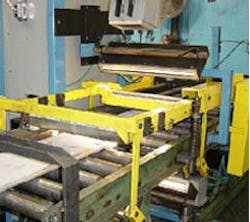Machine vision system detects cracks in slabs
Engineers at Averna Technologies (Montreal, Canada) have developed a machine vision system that detects 100-micron-size cracks on both sides of 400o Celsius aluminum slabs that are moving on a conveyor at 20 m/minute.
The system itself illuminates the slab with high intensity white light and captures images of the slab using two 8-MPixel linescan cameras positioned on either side of the slab.
The images from the camera are transferred to a PCI-1422 frame grabber from National Instruments (NI; Austin, TX) and analyzed by dual 2.8 GHz Xeon workstations running software built with the NI LabVIEW and image processing library. If a surface defect is detected, the PC actuates a system to mark the slab on the side.
One challenge that the engineers had to overcome was dealing with the 400oC temperature of the slabs. To do so, the cameras and illumination systems were housed in NEMA enclosures with forced cooling.
A semiautomatic procedure was developed to calibrate the system for light intensity, camera height and focus. To do so, the vision system acquires and analyzes reference images and guides an operator through an adjustment procedure. Once calibrated, the system displays the surface defects and statistics on how often they occur through a simple graphical user interface.
From conception to deployment, the complete system was developed in just five months.
More information on the design of the system is available here.
-- Dave Wilson, Senior Editor, Vision Systems Design
